A Review on Direct Laser Deposition of Inconel 625 and Inconel 625-Based Composites—Challenges and Prospects
Abstract
:1. Introduction
2. Wrought vs. Additive Manufactured IN625
Mechanical Properties
3. Microstructure and Phase Evolution in Direct Laser Deposited IN625
3.1. Laves Phase and Carbides
4. Creep Strength of DLD IN625
5. Fatigue Strength and Fracture Toughness of DLD IN625
Thermal–Mechanical Fatigue Resistance of DLD IN625
6. Effect of Laser/Powder Interaction
7. Fabrication of Inconel 625-Based Advanced Materials Using Laser-Directed Energy Deposition
7.1. IN625-Based Composites
Effect of Reinforcement on Mechanical Properties
7.2. Effect of Mixing
7.3. Effect of Reinforcement on Microstructure
8. Oxidation Resistance of DLD IN625 Composites
9. Corrosion Resistance of DLD IN625 Composites
10. Conclusions and Recommendations
- Rapid solidification in direct laser deposition of Inconel 625 essentially produces columnar dendritic structures, which results in anisotropic mechanical properties. A suitable additive reinforcement that may promote equiaxed grain growth could help eliminate or reduce the anisotropy in the resulting structure.
- The mechanical testing results showed a more pronounced increase in UTS with nano-sized particles as compared to micro-sized particles using equal weight % of reinforcements. An even dispersion of finer (nano-sized) particles will likely enhance the strength by dislocation pinning. However, nano-sized particles can agglomerate in resulting builds. A higher energy input has resulted in better dispersion of fine reinforcement particles throughout the matrix.
- The difference in strength along the horizontal direction (XY) and build (Z) direction of DLD IN625 can be attributed to the difference in grain boundary strength arising due to columnar microstructure. The difference in the microplastic strain along the horizontal (XY) direction and build (Z) direction arising due to the distribution of Laves phase particles results in a lower ductility in the horizontal direction as compared to the vertical direction in typical columnar dendritic builds of IN625.
- The ductility of Direct laser deposited IN625 is still lower than that of its wrought counterpart. A strategy to eliminate the Laves phases or modify the distribution and morphology of Laves phase is likely to enhance the ductility in DLD IN625 builds and may also result in better creep resistance. Microstructural modification by laser deposition parameters, scanning strategies, and subsequent heat treatments may be explored further to improve ductility and toughness. In-situ alloying may also prove helpful in this regard.
11. Future Research Directions and Prospects
- Process optimization: Future research could focus on optimizing the process parameters, such as laser power, layer thickness, powder flow rate, and scanning speed, to achieve lower porosity and higher deposition efficiency in DLD of IN625.
- Aerospace and defense: To utilize the DLD-IN625 for aerospace applications, high-temperature creep testing and thermomechanical testing data of DLD-IN625 are required, which necessitates further studies in this domain. IN625 and its composites could find significant applications, such as the manufacturing of gas turbine components, rocket engine parts, and heat exchangers.
- Material development and multi-material deposition: The potential of IN625-based composites can be further explored by studying oxides, carbides, and borides which have not been utilized/studied in detail as reinforcements with IN625 yet. More uniform mixing before deposition and optimization of laser processing parameters to achieve a homogenous distribution across the DLD build can pave the way for the industrial utility of IN625-based composites. The ability of DLD to deposit multiple materials in a single build could lead to the development of IN625-based functionally graded materials, which could exhibit tailored thermal, mechanical, and chemical properties for specific applications.
Author Contributions
Funding
Data Availability Statement
Conflicts of Interest
Appendix A
| Particle Size (µm) | Matrix wt.% | Rein. Wt.% | UTS | el.% | G.L/Width or G.L/Dia Ratio | HV | Source |
|---|---|---|---|---|---|---|---|
| 20–45/0.08–0.15 | 99.75 | 0.25 | 930 | 19 | 4/1 | 318 | [56] |
| 20–45/0.08–0.15 | 99.5 | 0.5 | 981 | 28 | 4/1 | 319 | [56] |
| 20–45/0.08–0.15 | 99 | 1 | 996 | 20 | 4/1 | 322 | [56] |
| 45–95/5–7 | 95 | 5 | 1077 | 21 | 4/1 | xx | [55] |
| 15–45/2–5 | 97.5 | 2.5 | 1023 | 14.7 | 3/1 | 314 | [57] |
| 15–45/0.04 | 97.5 | 2.5 | 1074 | 23.2 | 3/1 | 345 | [57] |
References
- Davis, J.R. 6.4.1 General Oxidation. In ASM Specialty Handbook—Nickel, Cobalt, and Their Alloys; ASM International: Materials Park, OH, USA, 2000; p. 86. [Google Scholar]
- Kutz, M. Mechanical Engineers’ Handbook—Materials and Engineering Mechanics, 4th ed.; John Wiley & Sons: Hoboken, NJ, USA, 2015. [Google Scholar]
- Zhu, D.; Zhang, X.; Ding, H. Tool wear characteristics in machining of nickel-based superalloys. Int. J. Mach. Tools Manuf. 2013, 64, 60–77. [Google Scholar] [CrossRef]
- Thakur, A.; Gangopadhyay, S. State-of-the-art in surface integrity in machining of nickel-based super alloys. Int. J. Mach. Tools Manuf. 2016, 100, 25–54. [Google Scholar] [CrossRef]
- Bourell, D.L.; Frazier, W.; Kuhn, H.; Seifi, M. 1. Introduction to Additive Manufacturing. In ASM Handbook®, Volume 24—Additive Manufacturing Processes; ASM International: Materials Park, OH, USA, 2020; pp. 3–10. [Google Scholar]
- DebRoy, T.; Wei, H.L.; Zuback, J.S.; Mukherjee, T.; Elmer, J.W.; Milewski, J.O.; Beese, A.M.; Wilson-Heid, A.; De, A.; Zhang, W. Additive manufacturing of metallic components—Process, structure and properties. Prog. Mater. Sci. 2018, 92, 112–224. [Google Scholar] [CrossRef]
- Pratheesh Kumar, S.; Elangovan, S.; Mohanraj, R.; Ramakrishna, J.R. A review on properties of Inconel 625 and Inconel 718 fabricated using direct energy deposition. Mater. Today: Proc. 2021, 46, 7892–7906. [Google Scholar] [CrossRef]
- Tan, C.; Weng, F.; Sui, S.; Chew, Y.; Bi, G. Progress and perspectives in laser additive manufacturing of key aeroengine materials. Int. J. Mach. Tools Manuf. 2021, 170, 103804. [Google Scholar] [CrossRef]
- Moeinfar, K.; Khodabakhshi, F.; Kashani-bozorg, S.F.; Mohammadi, M.; Gerlich, A.P. A review on metallurgical aspects of laser additive manufacturing (LAM): Stainless steels, nickel superalloys, and titanium alloys. J. Mater. Res. Technol. 2022, 16, 1029–1068. [Google Scholar] [CrossRef]
- Karmuhilan, M.; Kumanan, S. A Review on Additive Manufacturing Processes of Inconel 625. J. Mater. Eng. Perform. 2022, 31, 2583–2592. [Google Scholar] [CrossRef]
- Srinivasan, D.; Ananth, K. Recent Advances in Alloy Development for Metal Additive Manufacturing in Gas Turbine/Aerospace Applications: A Review. J. Indian Inst. Sci. 2022, 102, 311–349. [Google Scholar] [CrossRef]
- Zuback, J.S.; DebRoy, T. The Hardness of Additively Manufactured Alloys. Materials 2018, 11, 2070. [Google Scholar] [CrossRef] [PubMed]
- Sundararaman, M.; Mukhopadhyay, P.; Banerjee, S. Precipitation of the δ-Ni3Nb phase in two nickel base superalloys. Metall. Trans. A 1988, 19, 453–465. [Google Scholar] [CrossRef]
- De Oliveira, M.M.; Couto, A.A.; Almeida, G.F.C.; Reis, D.A.P.; de Lima, N.B.; Baldan, R. Mechanical Behavior of Inconel 625 at Elevated Temperatures. Metals 2019, 9, 301. [Google Scholar] [CrossRef]
- Han, F.F.; Zhou, B.M.; Huang, H.F.; Leng, B.; Lu, Y.L.; Dong, J.S.; Li, Z.J.; Zhou, X.T. The tensile behavior of GH3535 superalloy at elevated temperature. Mater. Chem. Phys. 2016, 182, 22–31. [Google Scholar] [CrossRef]
- Tian, C.; Cui, C.; Xu, L.; Gu, Y.; Sun, X. Dynamic Strain Aging in a Newly Developed Ni–Co-Base Superalloy with Low Stacking Fault Energy. J. Mater. Sci. Technol. 2013, 29, 873–878. [Google Scholar] [CrossRef]
- Smithells, C.J. Metals Reference Book, 7th ed.; Butterworths: London, UK, 1976. [Google Scholar]
- Pelloux, R.; Grant, N. Solid Solutions And Second Phase Strengthening of Nickel Alloys at High And Low Temperatures; Massachusetts Instutute of Technology, Deptarmetn of Metallurgy: Cambridge, MA, USA, 1959. [Google Scholar]
- Jena, A.K.; Chaturvedi, M.C. The role of alloying elements in the design of nickel-base superalloys. J. Mater. Sci. 1984, 19, 3121–3139. [Google Scholar] [CrossRef]
- Totten, G.E. 23.1 Wrought Nickel Alloys. In ASM Handbook Volume 4E—Heat Treating of Nonferrous Alloys; ASM International: Materials Park, OH, USA, 2016; p. 427. [Google Scholar]
- Semiatin, S.L. ASM Handbook: Volume 14A—Metalworking: Bulk Forming; ASM International: Materials Park, OH, USA, 2005; p. 329. [Google Scholar]
- Slotwinski, J.; Slotwinski, J.; Moylan, S. Applicability of Existing Materials Testing Standards for Additive Manufacturing Materials; US Department of Commerce, National Institute of Standards and Technology: Gaithersburg, MD, USA, 2014. [Google Scholar]
- Chen, F.; Wang, Q.; Zhang, C.; Huang, Z.; Jia, M.; Shen, Q. Microstructures and mechanical behaviors of additive manufactured Inconel 625 alloys via selective laser melting and laser engineered net shaping. J. Alloys Compd. 2022, 917, 165572. [Google Scholar] [CrossRef]
- Nguejio, J.; Szmytka, F.; Hallais, S.; Tanguy, A.; Nardone, S.; Godino Martinez, M. Comparison of microstructure features and mechanical properties for additive manufactured and wrought nickel alloys 625. Mater. Sci. Eng. A 2019, 764, 138214. [Google Scholar] [CrossRef]
- Ferreira, A.A.; Reis, A.R.; Amaral, R.L.; Cruz, J.M.; Romio, P.C.; Seabra, J.O.; Vieira, M.F. Mechanical and microstructural characterisation of bulk Inconel 625 produced by direct laser deposition. Mater. Sci. Eng. A 2022, 838, 142777. [Google Scholar] [CrossRef]
- Khayat, Z.R.; Palmer, T.A. Impact of iron composition on the properties of an additively manufactured solid solution strengthened nickel base alloy. Mater. Sci. Eng. A 2018, 718, 123–134. [Google Scholar] [CrossRef]
- ASTM F3056; Standard Specification for Additive Manufacturing Nickel Alloy (UNS N06625) with Powder Bed Fusion. ASTM: West Conshohocken, PA, USA, 2021; p. 8. [CrossRef]
- Rombouts, M.; Maes, G.; Mertens, M.; Hendrix, W. Laser metal deposition of Inconel 625: Microstructure and mechanical properties. J. Laser Appl. 2012, 24, 052007. [Google Scholar] [CrossRef]
- ASTM B443; Standard Specification for Nickel-Chromium-Molybdenum-Columbium Alloy and Nickel-Chromium-Molybdenum-Silicon Alloy Plate, Sheet, and Strip. ASTM: West Conshohocken, PA, USA, 2019; p. 8. [CrossRef]
- Hu, Y.L.; Li, Y.L.; Zhang, S.Y.; Lin, X.; Wang, Z.H.; Huang, W.D. Effect of solution temperature on static recrystallization and ductility of Inconel 625 superalloy fabricated by directed energy deposition. Mater. Sci. Eng. A 2020, 772, 138711. [Google Scholar] [CrossRef]
- Kreitcberg, A.; Brailovski, V.; Turenne, S. Effect of heat treatment and hot isostatic pressing on the microstructure and mechanical properties of Inconel 625 alloy processed by laser powder bed fusion. Mater. Sci. Eng. A 2017, 689, 1–10. [Google Scholar] [CrossRef]
- Hu, Y.; Lin, X.; Li, Y.; Ou, Y.; Gao, X.; Zhang, Q.; Li, W.; Huang, W. Microstructural evolution and anisotropic mechanical properties of Inconel 625 superalloy fabricated by directed energy deposition. J. Alloys Compd. 2021, 870, 159426. [Google Scholar] [CrossRef]
- Guidelines for Determining Coordinate Systems and Testing Methodologies in AM Processes; ASTM: West Conshohocken, PA, USA, 2019; p. 14. [CrossRef]
- Dinda, G.P.; Dasgupta, A.K.; Mazumder, J. Laser aided direct metal deposition of Inconel 625 superalloy: Microstructural evolution and thermal stability. Mater. Sci. Eng. A 2009, 509, 98–104. [Google Scholar] [CrossRef]
- Li, S.; Wei, Q.; Shi, Y.; Zhu, Z.; Zhang, D. Microstructure Characteristics of Inconel 625 Superalloy Manufactured by Selective Laser Melting. J. Mater. Sci. Technol. 2015, 31, 946–952. [Google Scholar] [CrossRef]
- Rai, S.K.; Kumar, A.; Shankar, V.; Jayakumar, T.; Bhanu Sankara Rao, K.; Raj, B. Characterization of microstructures in Inconel 625 using X-ray diffraction peak broadening and lattice parameter measurements. Scr. Mater. 2004, 51, 59–63. [Google Scholar] [CrossRef]
- Luna, V.; Trujillo, L.; Gamon, A.; Arrieta, E.; Murr, L.E.; Wicker, R.B.; Katsarelis, C.; Gradl, P.R.; Medina, F. Comprehensive and Comparative Heat Treatment of Additively Manufactured Inconel 625 Alloy and Corresponding Microstructures and Mechanical Properties. J. Manuf. Mater. Process. 2022, 6, 107. [Google Scholar] [CrossRef]
- Qin, L.; Chen, C.; Zhang, M.; Yan, K.; Cheng, G.; Jing, H.; Wang, X. The microstructure and mechanical properties of deposited-IN625 by laser additive manufacturing. Rapid Prototyp. J. 2017, 23, 1119–1129. [Google Scholar] [CrossRef]
- Xingcheng, W.; Chen, C.; Qin, L.; Zhang, M. Microstructure Evolution and Mechanical Behavior of Inconel 625 Produced Using Direct Laser Metal Deposition. Phys. Met. Metallogr. 2021, 122, 896–907. [Google Scholar] [CrossRef]
- Davis, J.R. 3.3 References. In ASM Specialty Handbook—Nickel, Cobalt, and Their Alloys; ASM International: Materials Park, OH, USA, 2000; p. 5. [Google Scholar]
- Floreen, S.; Fuchs, G.E.; Yang, W.J.S. The Metallurgy of Alloy 625. In Superalloys; Knolls Atomic Power Laboratory: Niskayuna, NY, USA, 1994; pp. 13–37. [Google Scholar]
- Reed, R.C. The Superalloys: Fundamentals and Applications; Cambridge University Press: Cambridge, UK, 2008. [Google Scholar]
- Sundararaman, M.; Mukhopadhyay, P.; Banerjee, S. Carbide precipitation in nickel base superalloys 718 and 625 and their effect on mechanical properties. Superalloys 1997, 718, 367–378. [Google Scholar]
- Lass, E.A.; Stoudt, M.R.; Williams, M.E.; Katz, M.B.; Levine, L.E.; Phan, T.Q.; Gnaeupel-Herold, T.H.; Ng, D.S. Formation of the Ni3Nb δ-Phase in Stress-Relieved Inconel 625 Produced via Laser Powder-Bed Fusion Additive Manufacturing. Metall. Mater. Trans. A 2017, 48, 5547–5558. [Google Scholar] [CrossRef]
- Stoudt, M.R.; Lass, E.; Ng, D.S.; Williams, M.E.; Zhang, F.; Campbell, C.E.; Lindwall, G.; Levine, L.E. The influence of annealing temperature and time on the formation of δ-phase in additively-manufactured Inconel 625. Metall. Mater. Trans. A 2018, 49, 3028–3037. [Google Scholar] [CrossRef]
- Son, K.-T.; Phan, T.Q.; Levine, L.E.; Kim, K.-S.; Lee, K.-A.; Ahlfors, M.; Kassner, M.E. The creep and fracture properties of additively manufactured inconel 625. Materialia 2021, 15, 101021. [Google Scholar] [CrossRef]
- Poulin, J.-R.; Kreitcberg, A.; Terriault, P.; Brailovski, V. Long fatigue crack propagation behavior of laser powder bed-fused inconel 625 with intentionally-seeded porosity. Int. J. Fatigue 2019, 127, 144–156. [Google Scholar] [CrossRef]
- Poulin, J.-R.; Kreitcberg, A.; Terriault, P.; Brailovski, V. Fatigue strength prediction of laser powder bed fusion processed Inconel 625 specimens with intentionally-seeded porosity: Feasibility study. Int. J. Fatigue 2020, 132, 105394. [Google Scholar] [CrossRef]
- Theriault, A.; Xue, L.; Dryden, J.R. Fatigue behavior of laser consolidated IN-625 at room and elevated temperatures. Mater. Sci. Eng. A 2009, 516, 217–225. [Google Scholar] [CrossRef]
- Klein Fiorentin, F.; Maciel, D.; Gil, J.; Figueiredo, M.; Berto, F.; de Jesus, A. Fatigue Assessment of Inconel 625 Produced by Directed Energy Deposition from Miniaturized Specimens. Metals 2022, 12, 156. [Google Scholar] [CrossRef]
- Kim, K.-S.; Kang, T.-H.; Kassner, M.E.; Son, K.-T.; Lee, K.-A. High-temperature tensile and high cycle fatigue properties of inconel 625 alloy manufactured by laser powder bed fusion. Addit. Manuf. 2020, 35, 101377. [Google Scholar] [CrossRef]
- Manvatkar, V.; De, A.; DebRoy, T. Heat transfer and material flow during laser assisted multi-layer additive manufacturing. J. Appl. Phys. 2014, 116, 124905. [Google Scholar] [CrossRef]
- Bourell, D.L.; Frazier, W.; Kuhn, H.; Seifi, M. 20.4.1 Fundamental Process Parameters. In ASM Handbook®, Volume 24—Additive Manufacturing Processes; ASM International: Materials Park, OH, USA, 2020; pp. 225–226. [Google Scholar]
- Bourell, D.L.; Frazier, W.; Kuhn, H.; Seifi, M. ASM Handbook®, Volume 24—Additive Manufacturing Processes; ASM International: Materials Park, OH, USA, 2020. [Google Scholar]
- Hong, C.; Gu, D.; Dai, D.; Alkhayat, M.; Urban, W.; Yuan, P.; Cao, S.; Gasser, A.; Weisheit, A.; Kelbassa, I.; et al. Laser additive manufacturing of ultrafine TiC particle reinforced Inconel 625 based composite parts: Tailored microstructures and enhanced performance. Mater. Sci. Eng. A 2015, 635, 118–128. [Google Scholar] [CrossRef]
- Bi, G.; Sun, C.N.; Nai, M.L.; Wei, J. Micro-structure and Mechanical Properties of Nano-TiC Reinforced Inconel 625 Deposited using LAAM. Phys. Procedia 2013, 41, 828–834. [Google Scholar] [CrossRef]
- Gu, D.; Cao, S.; Lin, K. Laser Metal Deposition Additive Manufacturing of TiC Reinforced Inconel 625 Composites: Influence of the Additive TiC Particle and Its Starting Size. J. Manuf. Sci. Eng. 2016, 139, 041014. [Google Scholar] [CrossRef]
- Cao, S.; Gu, D. Laser metal deposition additive manufacturing of TiC/Inconel 625 nanocomposites: Relation of densification, microstructures and performance. J. Mater. Res. 2015, 30, 3616–3628. [Google Scholar] [CrossRef]
- Chen, L.; Sun, Y.; Li, L.; Ren, Y.; Ren, X. In situ TiC/Inconel 625 nanocomposites fabricated by selective laser melting: Densification behavior, microstructure evolution, and wear properties. Appl. Surf. Sci. 2020, 518, 145981. [Google Scholar] [CrossRef]
- Shen, M.-Y.; Tian, X.-J.; Liu, D.; Tang, H.-B.; Cheng, X. Microstructure and fracture behavior of TiC particles reinforced Inconel 625 composites prepared by laser additive manufacturing. J. Alloys Compd. 2018, 734, 188–195. [Google Scholar] [CrossRef]
- Jiang, D.; Hong, C.; Zhong, M.; Alkhayat, M.; Weisheit, A.; Gasser, A.; Zhang, H.; Kelbassa, I.; Poprawe, R. Fabrication of nano-TiCp reinforced Inconel 625 composite coatings by partial dissolution of micro-TiCp through laser cladding energy input control. Surf. Coat. Technol. 2014, 249, 125–131. [Google Scholar] [CrossRef]
- Zhang, B.; Bi, G.; Wang, P.; Bai, J.; Chew, Y.; Nai, M.S. Microstructure and mechanical properties of Inconel 625/nano-TiB2 composite fabricated by LAAM. Mater. Des. 2016, 111, 70–79. [Google Scholar] [CrossRef]
- Promakhov, V.; Matveev, A.; Klimova-Korsmik, O.; Schulz, N.; Bakhmat, V.; Babaev, A.; Vorozhtsov, A. Structure and Properties of Metal-Matrix Composites Based on an Inconel 625—TiB2 System Fabricated by Additive Manufacturing. Metals 2022, 12, 525. [Google Scholar] [CrossRef]
- Janicki, D.; Musztyfaga, M.M. Direct Diode Laser Cladding of Inconel 625/WC Composite Coatings. Stroj. Vestn. J. Mech. Eng. 2016, 62, 10. [Google Scholar] [CrossRef]
- Li, W.; Di, R.; Yuan, R.; Song, H.; Lei, J. Microstructure, wear resistance and electrochemical properties of spherical/non-spherical WC reinforced Inconel 625 superalloy by laser melting deposition. J. Manuf. Process. 2022, 74, 413–422. [Google Scholar] [CrossRef]
- Hansen, N. Hall–Petch relation and boundary strengthening. Scr. Mater. 2004, 51, 801–806. [Google Scholar] [CrossRef]
- Roth, H.; Davis, C.; Thomson, R. Modeling solid solution strengthening in nickel alloys. Metall. Mater. Trans. A 1997, 28, 1329–1335. [Google Scholar] [CrossRef]
- Cooper, D.E.; Blundell, N.; Maggs, S.; Gibbons, G.J. Additive layer manufacture of Inconel 625 metal matrix composites, reinforcement material evaluation. J. Mater. Process. Technol. 2013, 213, 2191–2200. [Google Scholar] [CrossRef]
- Bazaleeva, K.; Aleksandrova, A.; Balakirev, E. Structure features of the composite materials Inconel 625/TiC, produced by LMD method. J. Phys. Conf. Ser. 2018, 1109, 012053. [Google Scholar] [CrossRef]
- Wilson, J.M.; Shin, Y.C. Microstructure and wear properties of laser-deposited functionally graded Inconel 690 reinforced with TiC. Surf. Coat. Technol. 2012, 207, 517–522. [Google Scholar] [CrossRef]
- Hong, C.; Gu, D.; Dai, D.; Cao, S.; Alkhayat, M.; Jia, Q.; Gasser, A.; Weisheit, A.; Kelbassa, I.; Zhong, M.; et al. High-temperature oxidation performance and its mechanism of TiC/Inconel 625 composites prepared by laser metal deposition additive manufacturing. J. Laser Appl. 2015, 27, S17005. [Google Scholar] [CrossRef]
- Tian, Z.-H.; Zhao, Y.-T.; Jiang, Y.-J.; Ren, H.-P. Microstructure and properties of Inconel 625 + WC composite coatings prepared by laser cladding. Rare Met. 2021, 40, 2281–2291. [Google Scholar] [CrossRef]
- Huebner, J.; Kusiński, J.; Rutkowski, P.; Kata, D. Microstructural and mechanical study of inconel 625–tungsten carbide composite coatings obtained by powder laser cladding. Arch. Metall. Mater. 2017, 2, 531–538. [Google Scholar] [CrossRef]


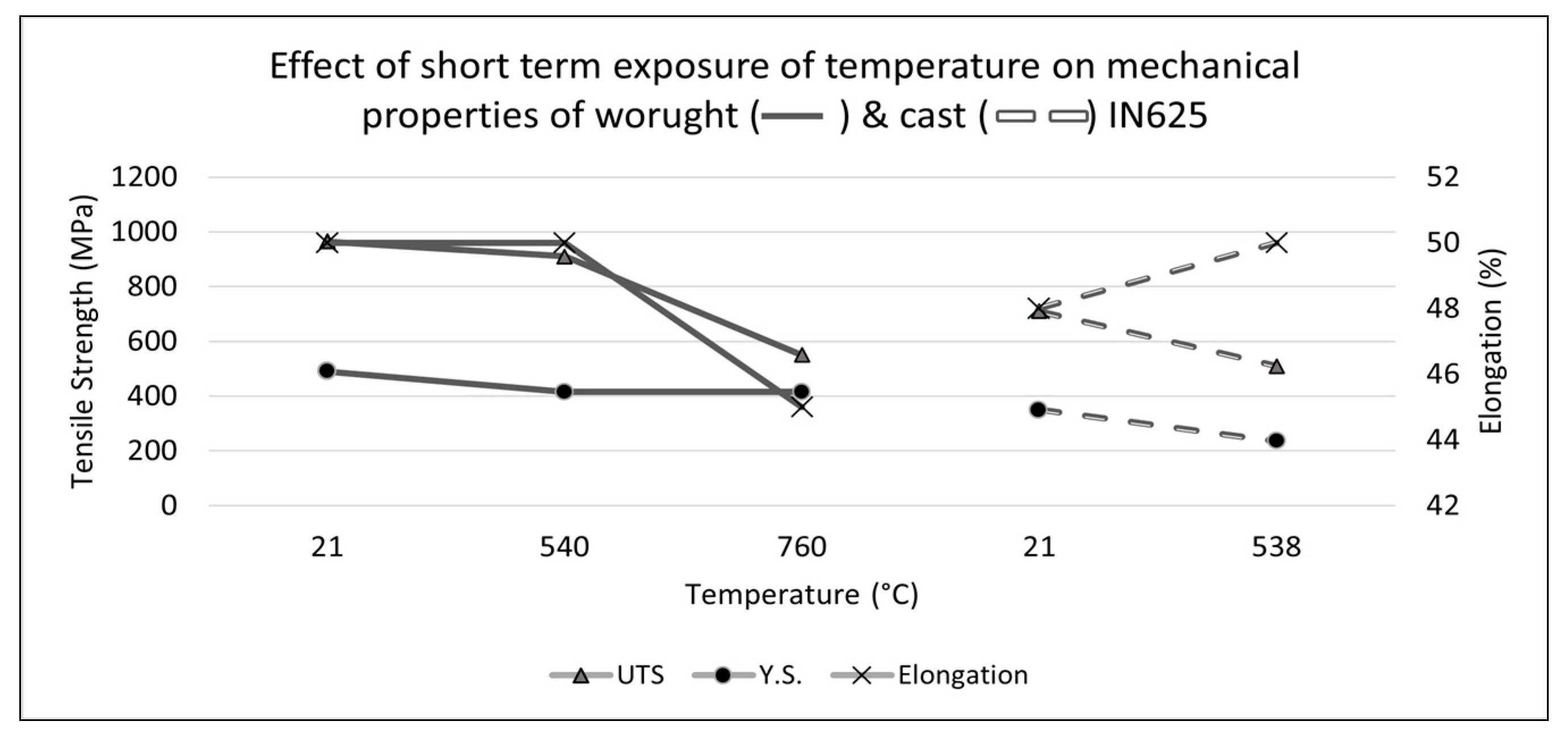
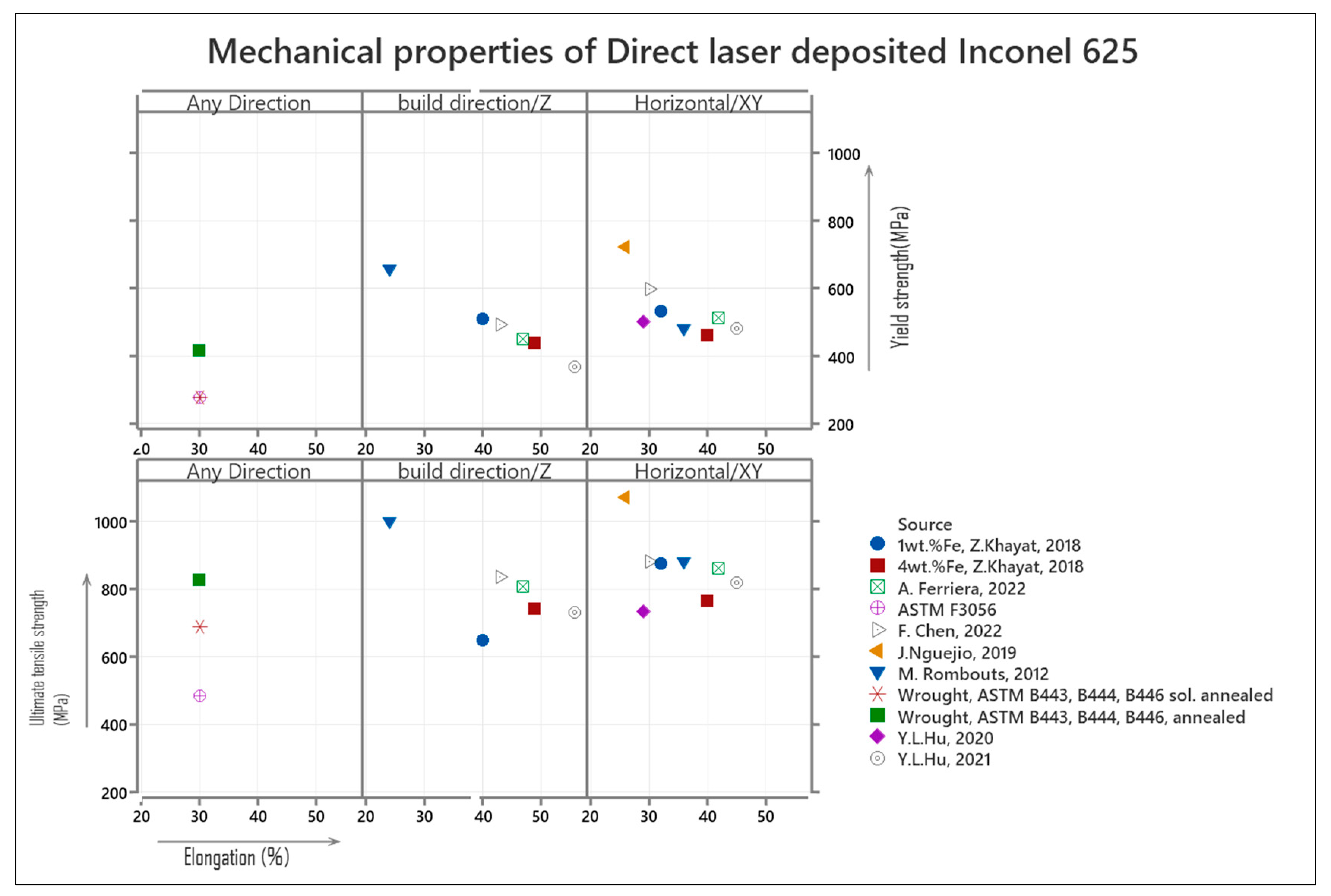
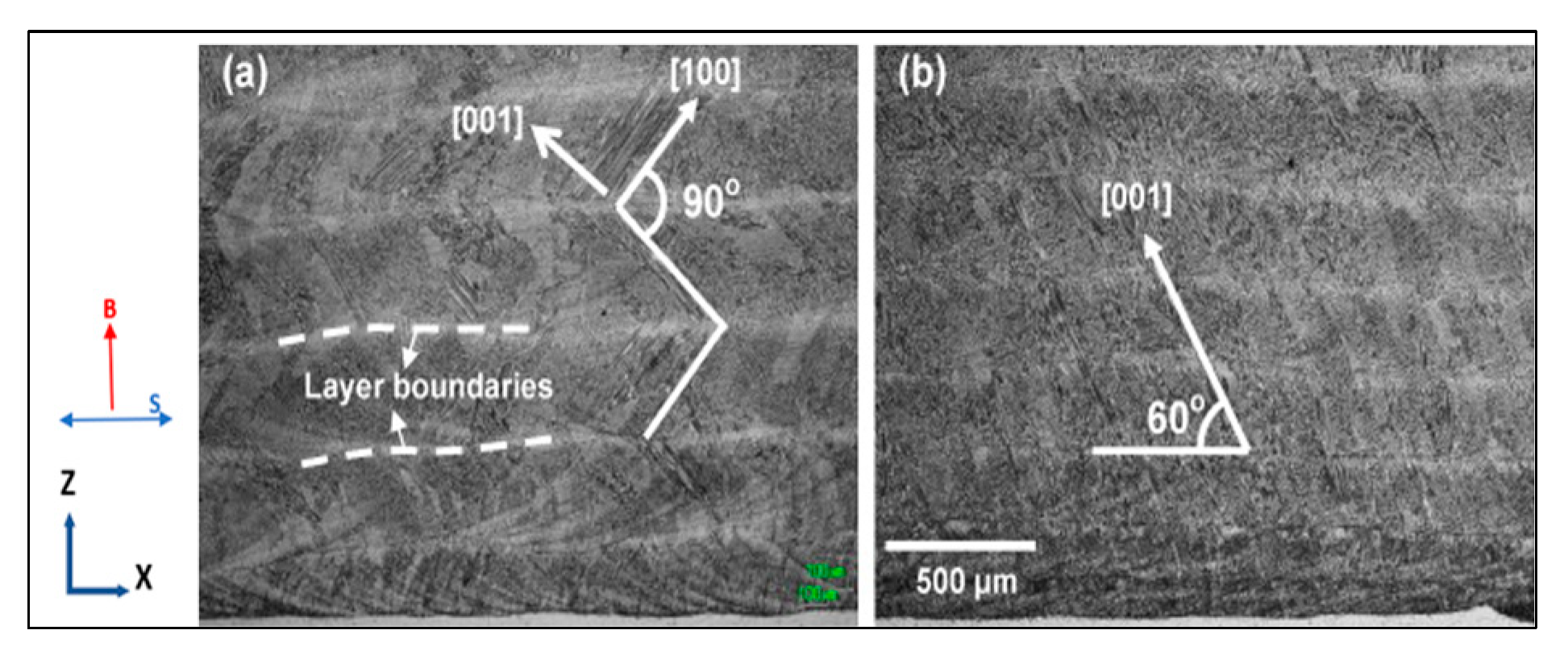
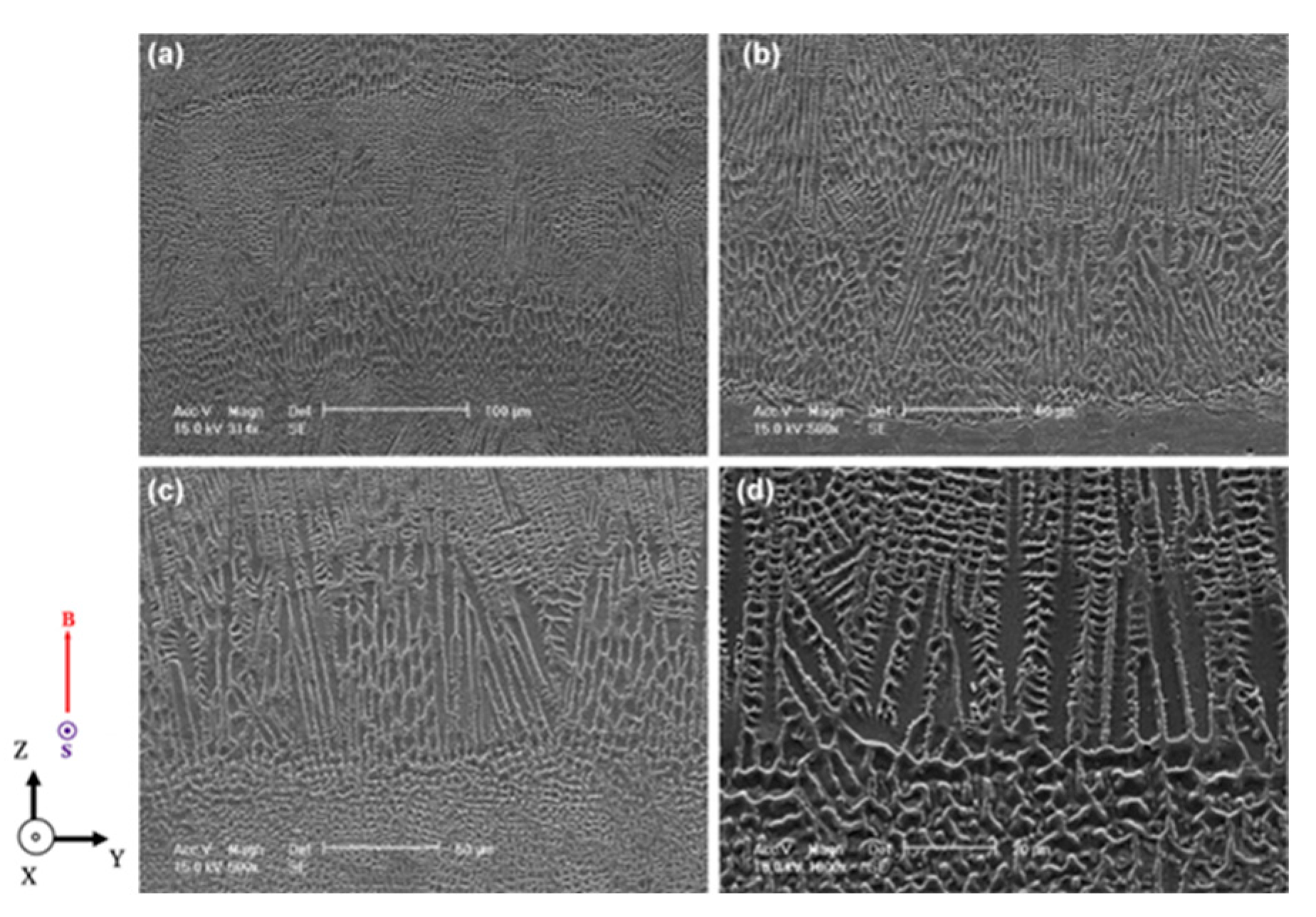

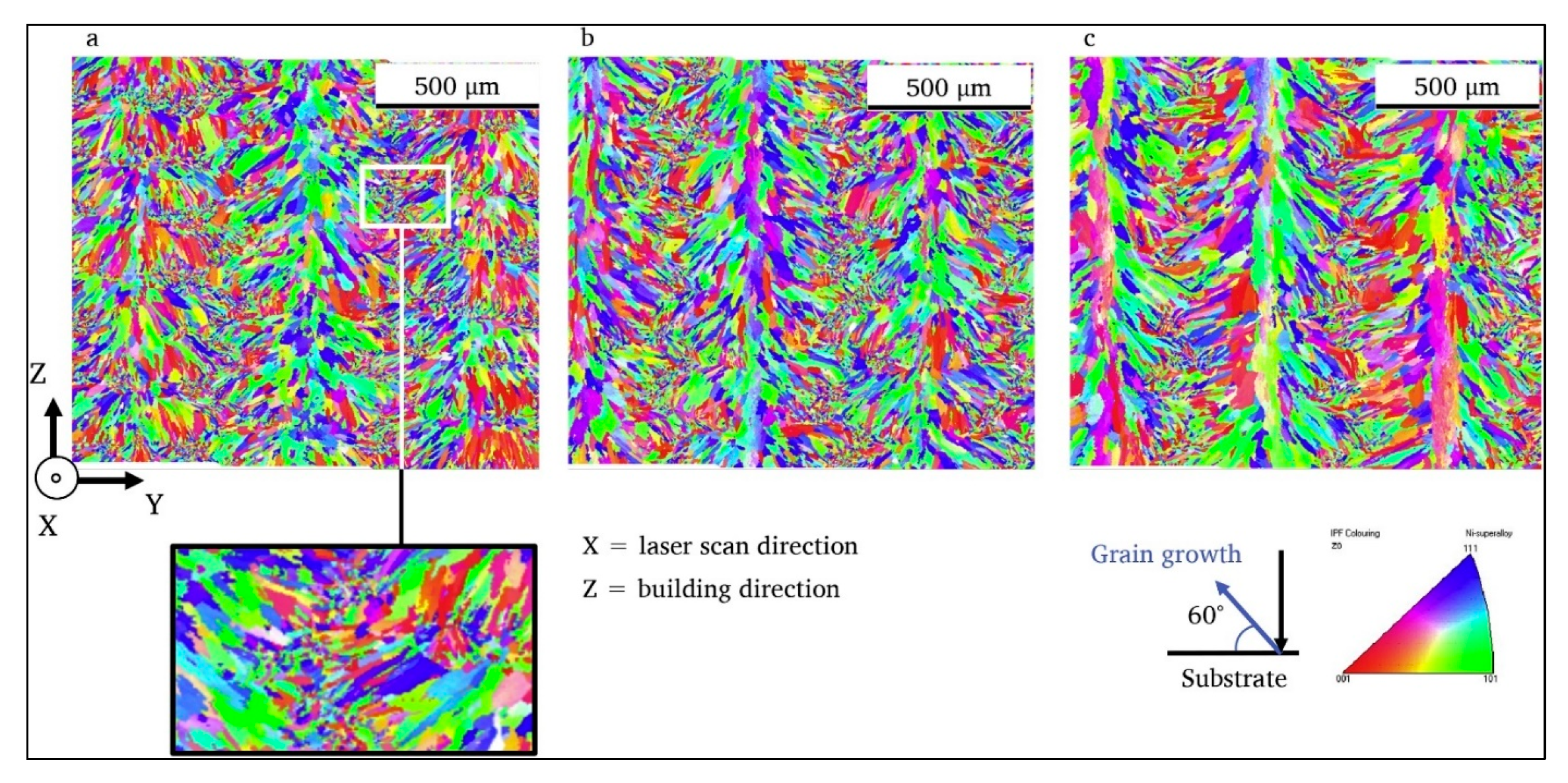

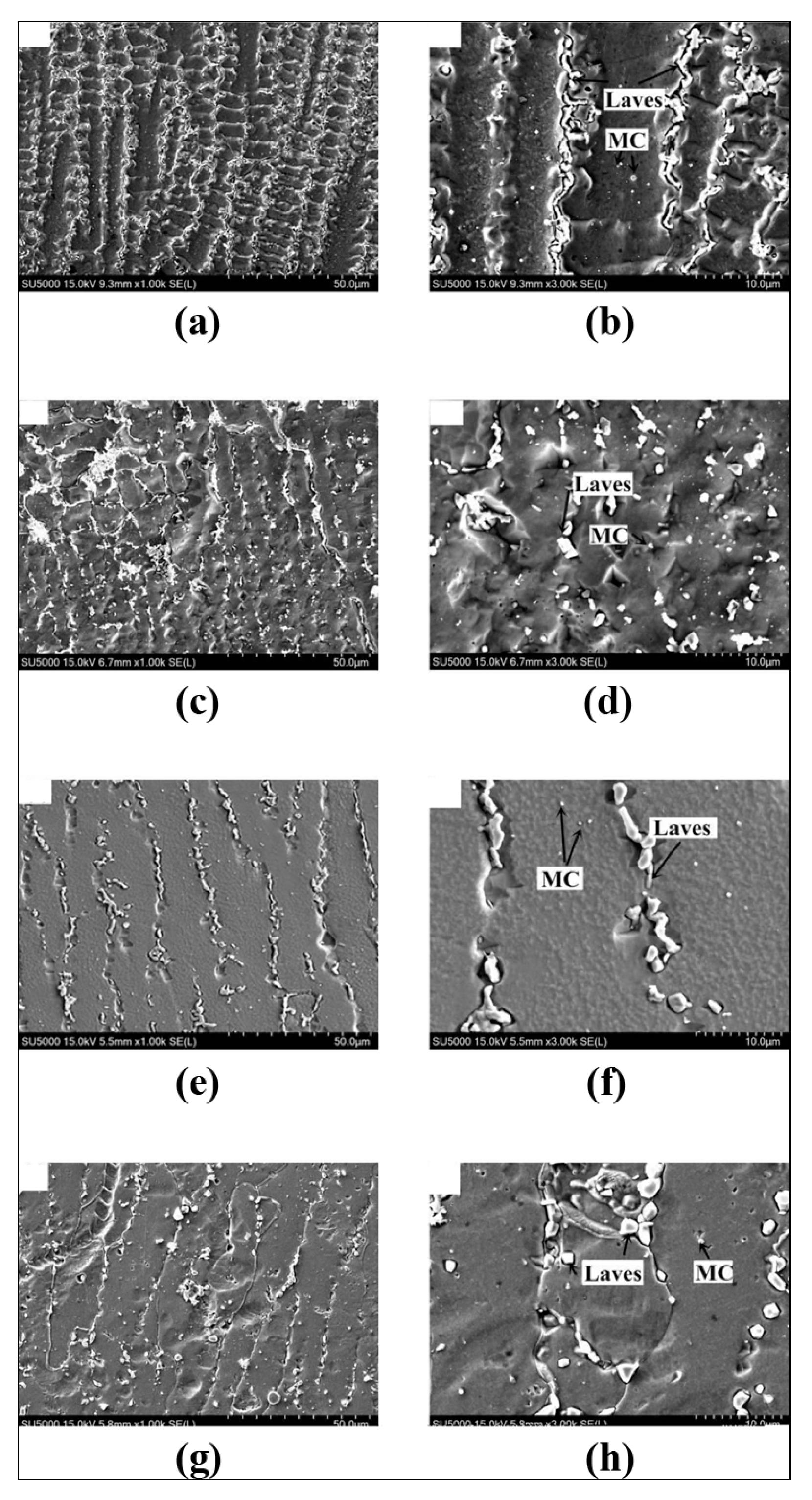
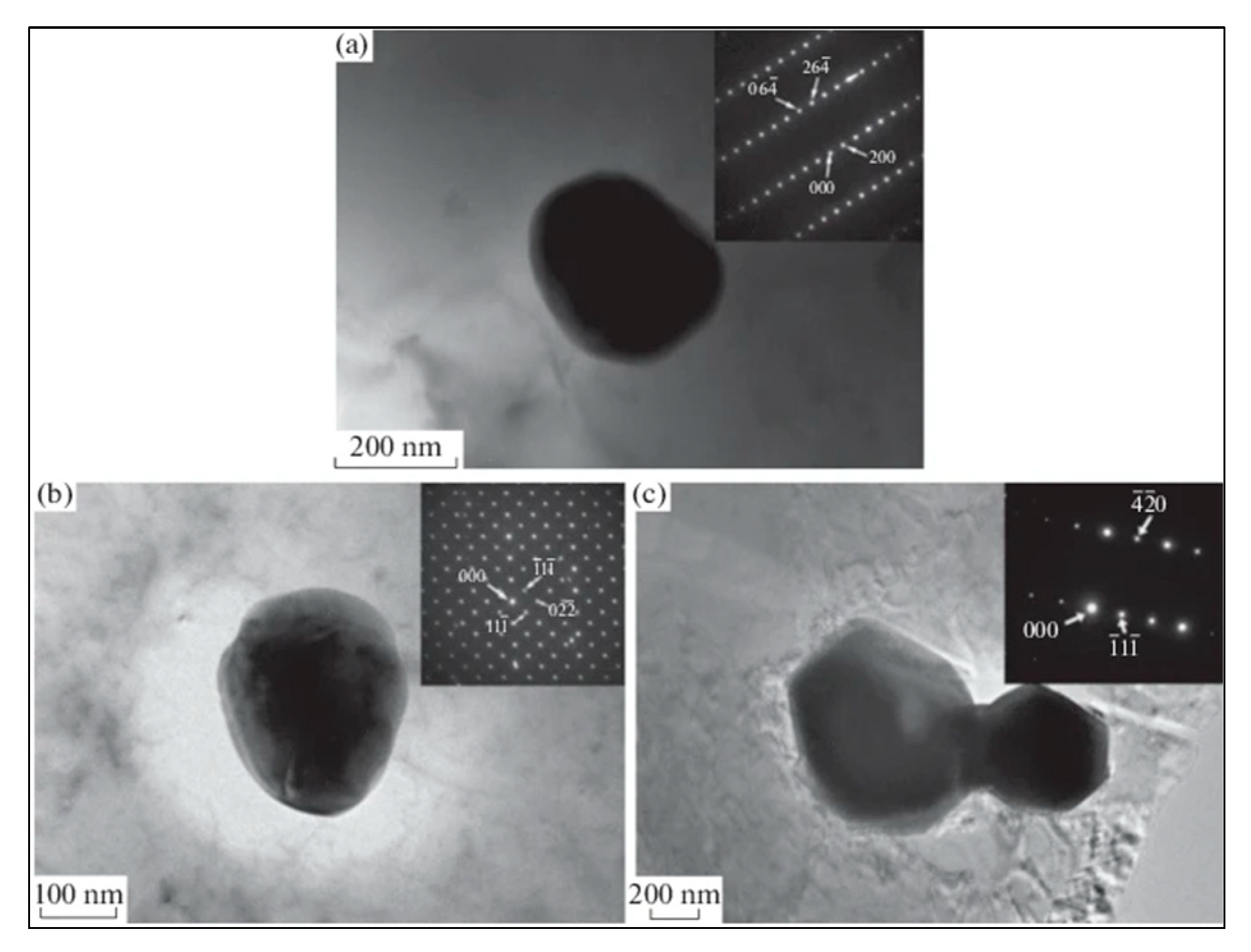
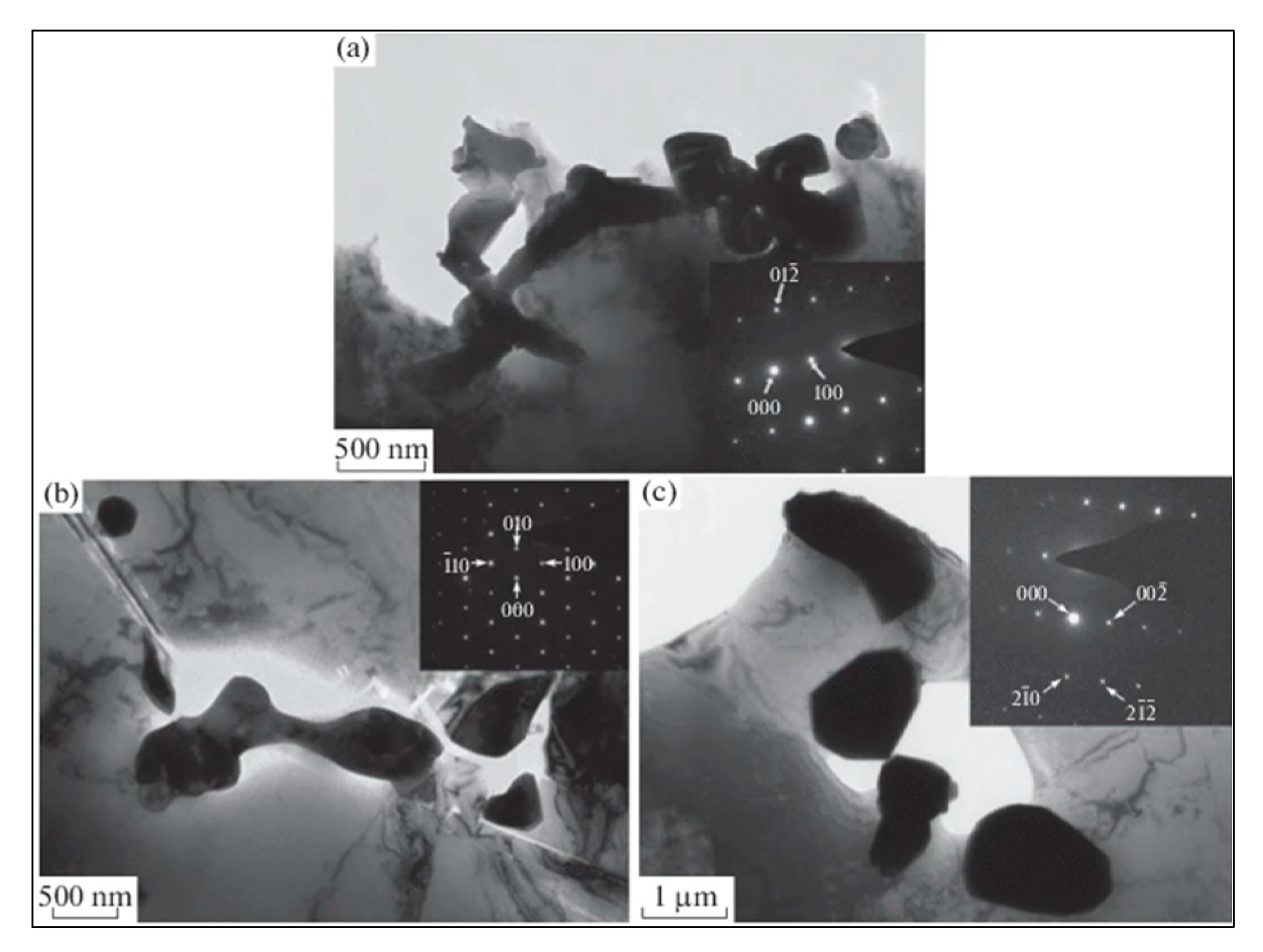

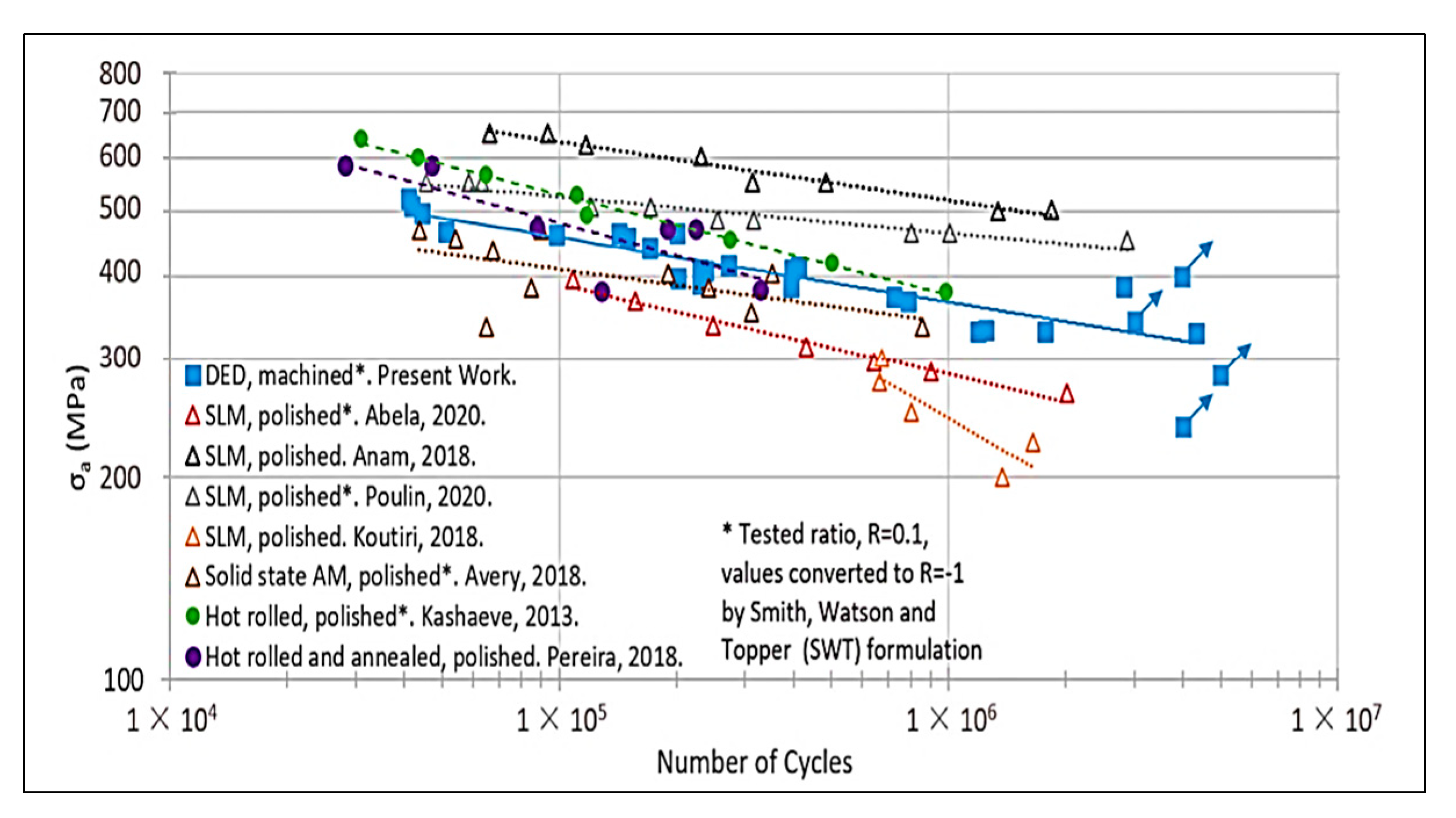
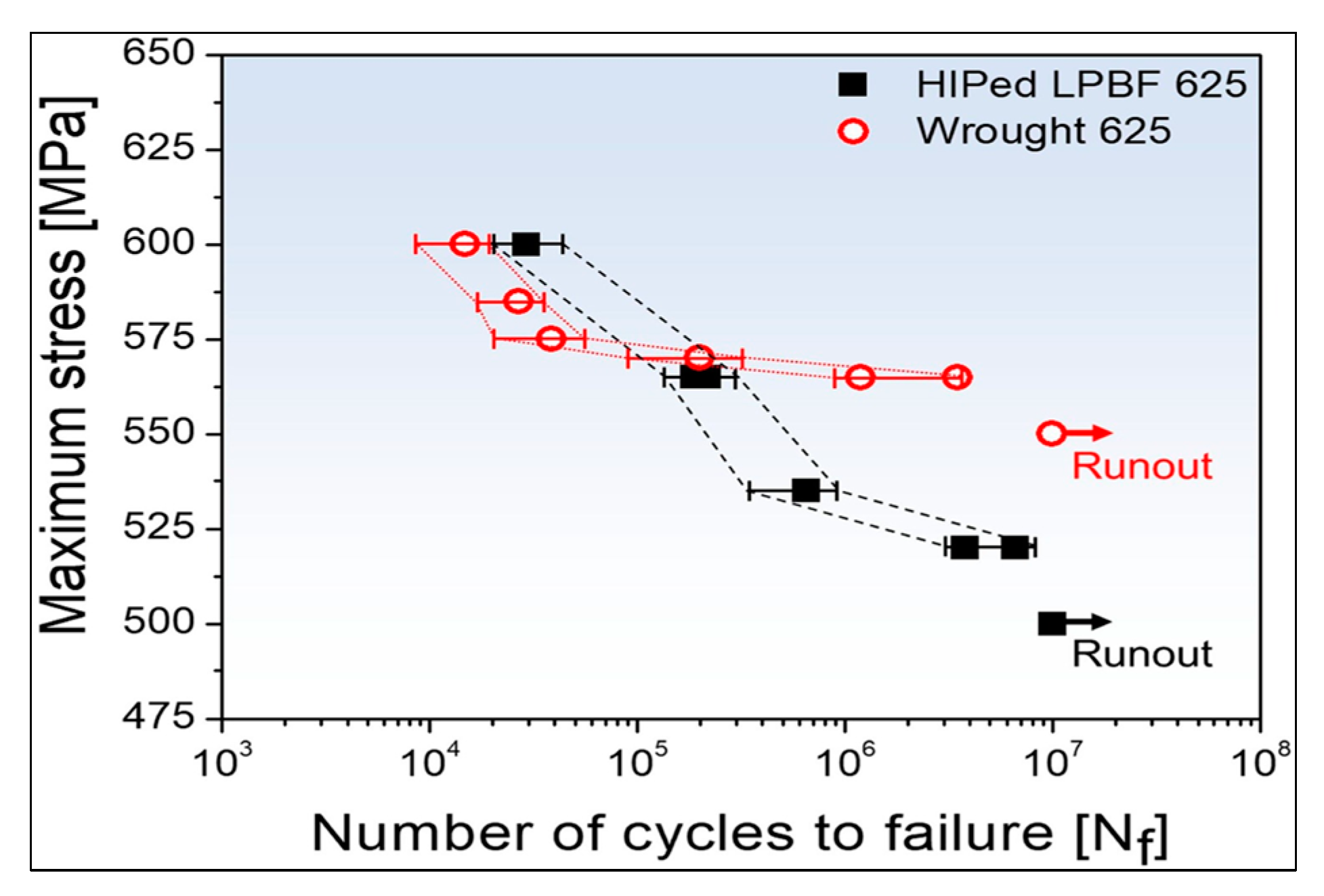

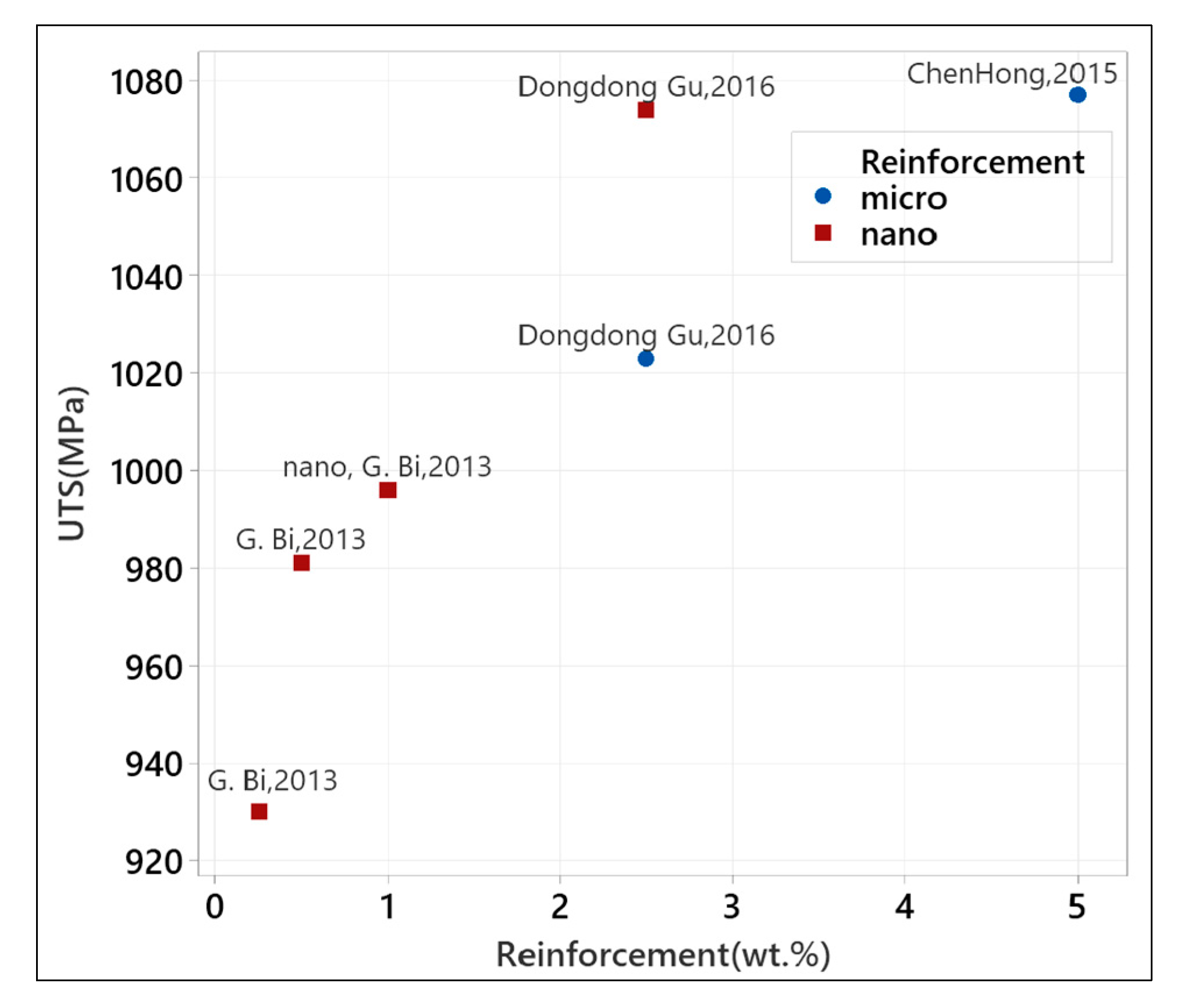
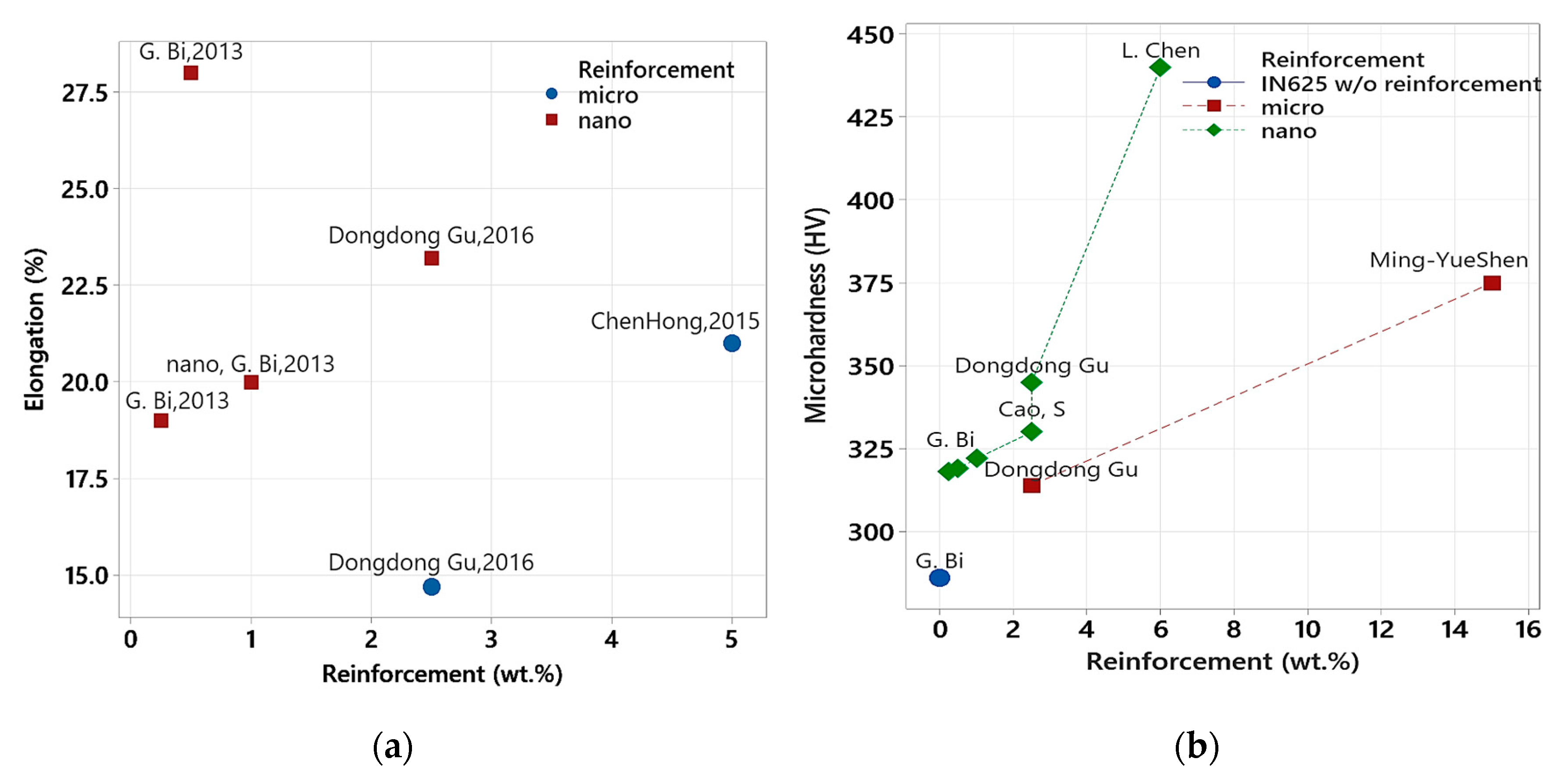
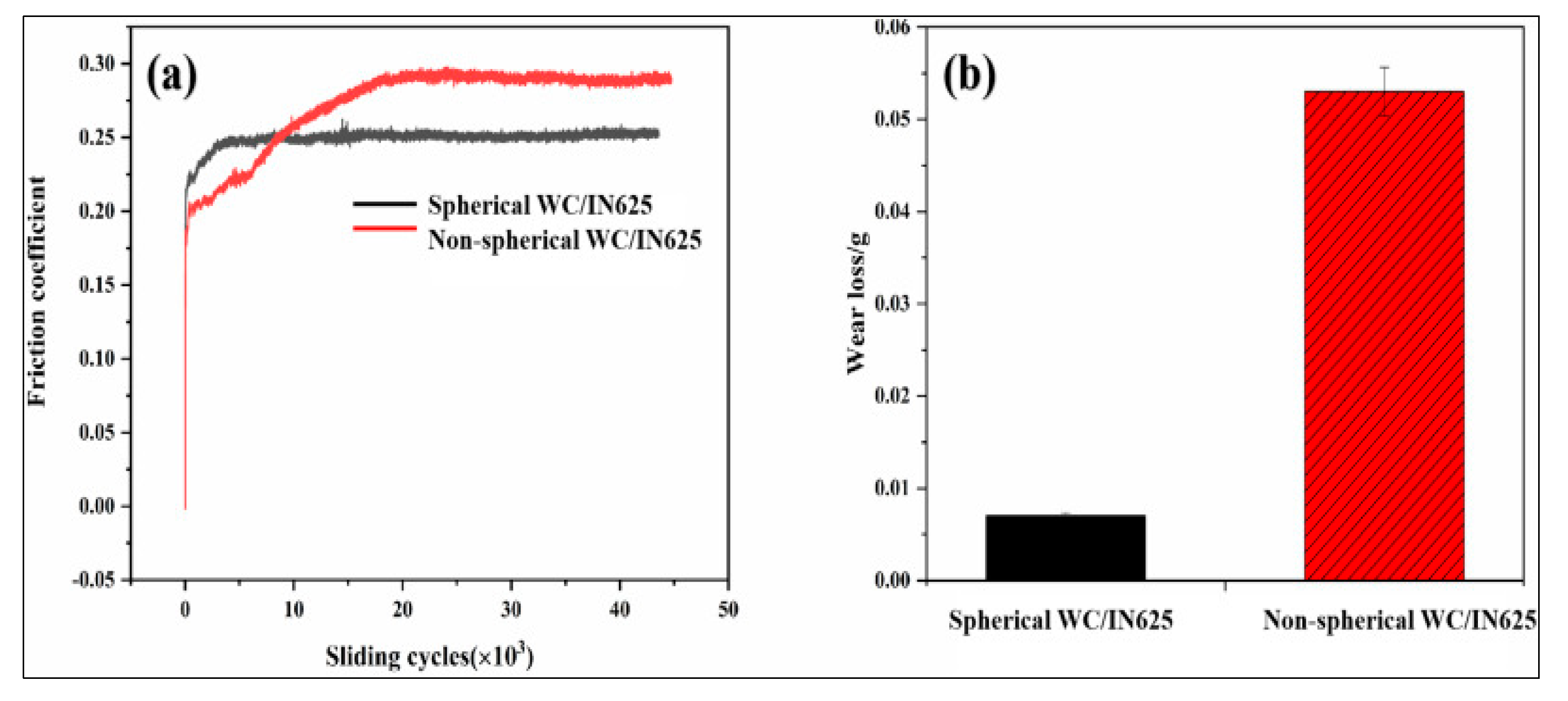
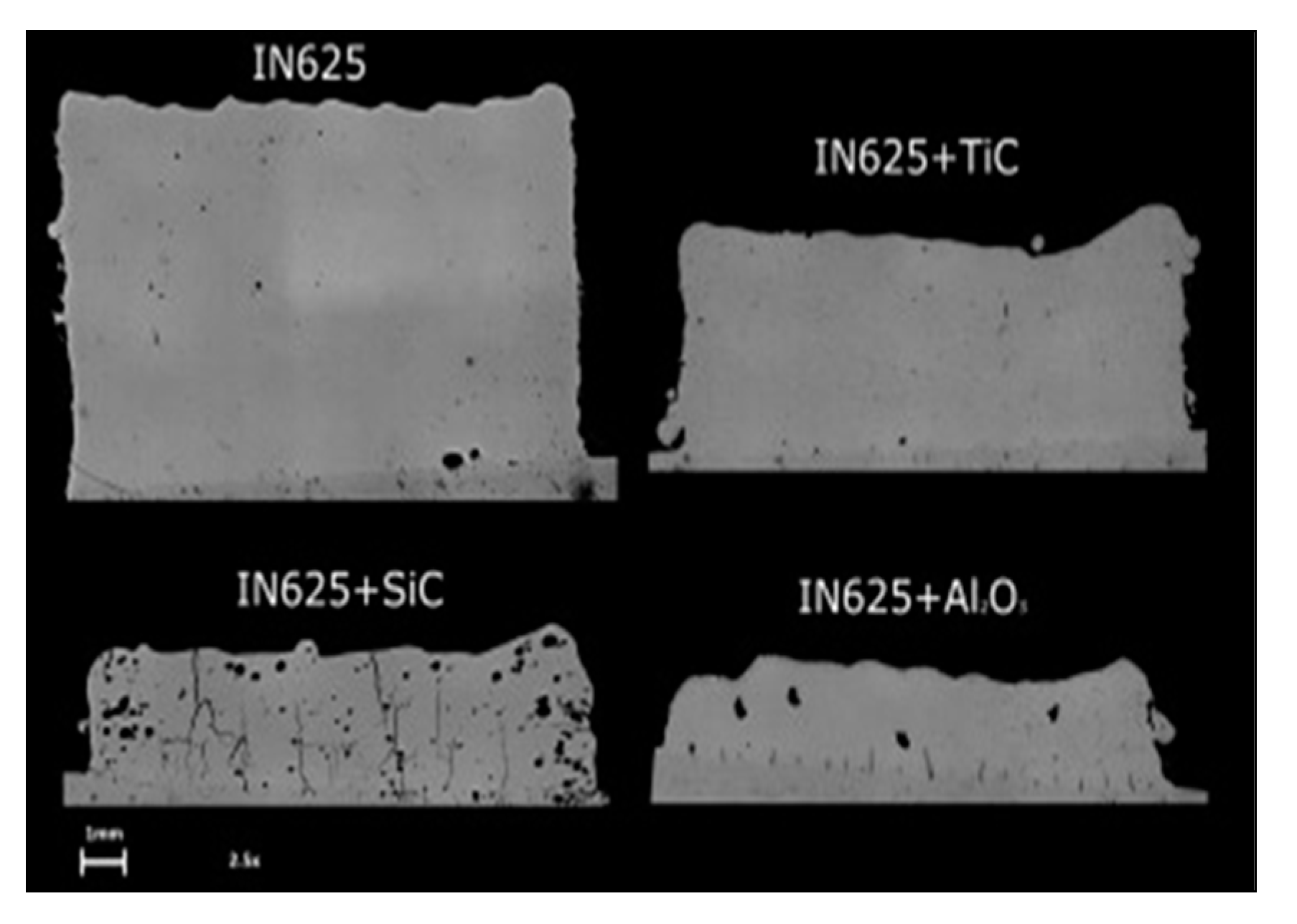

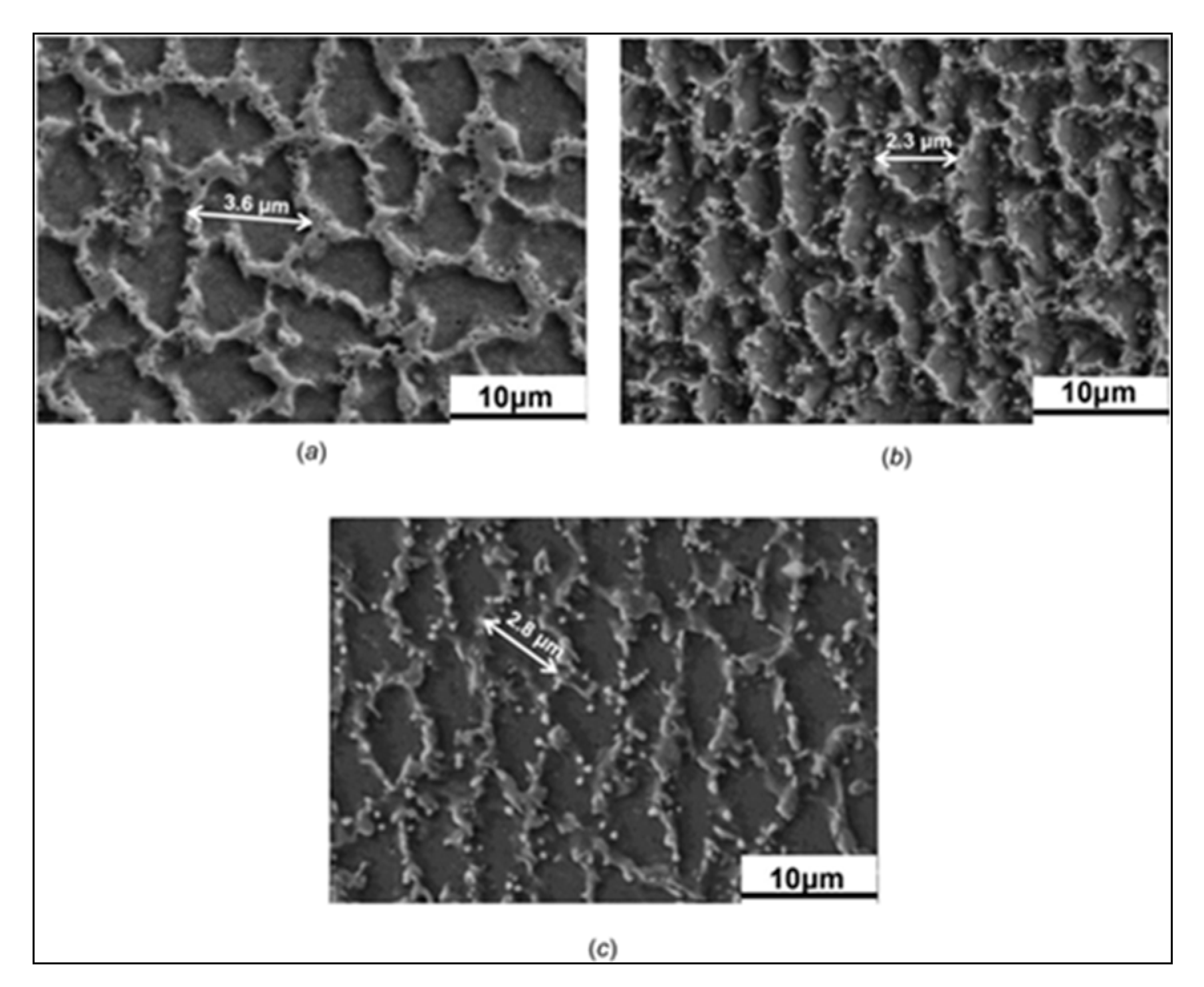


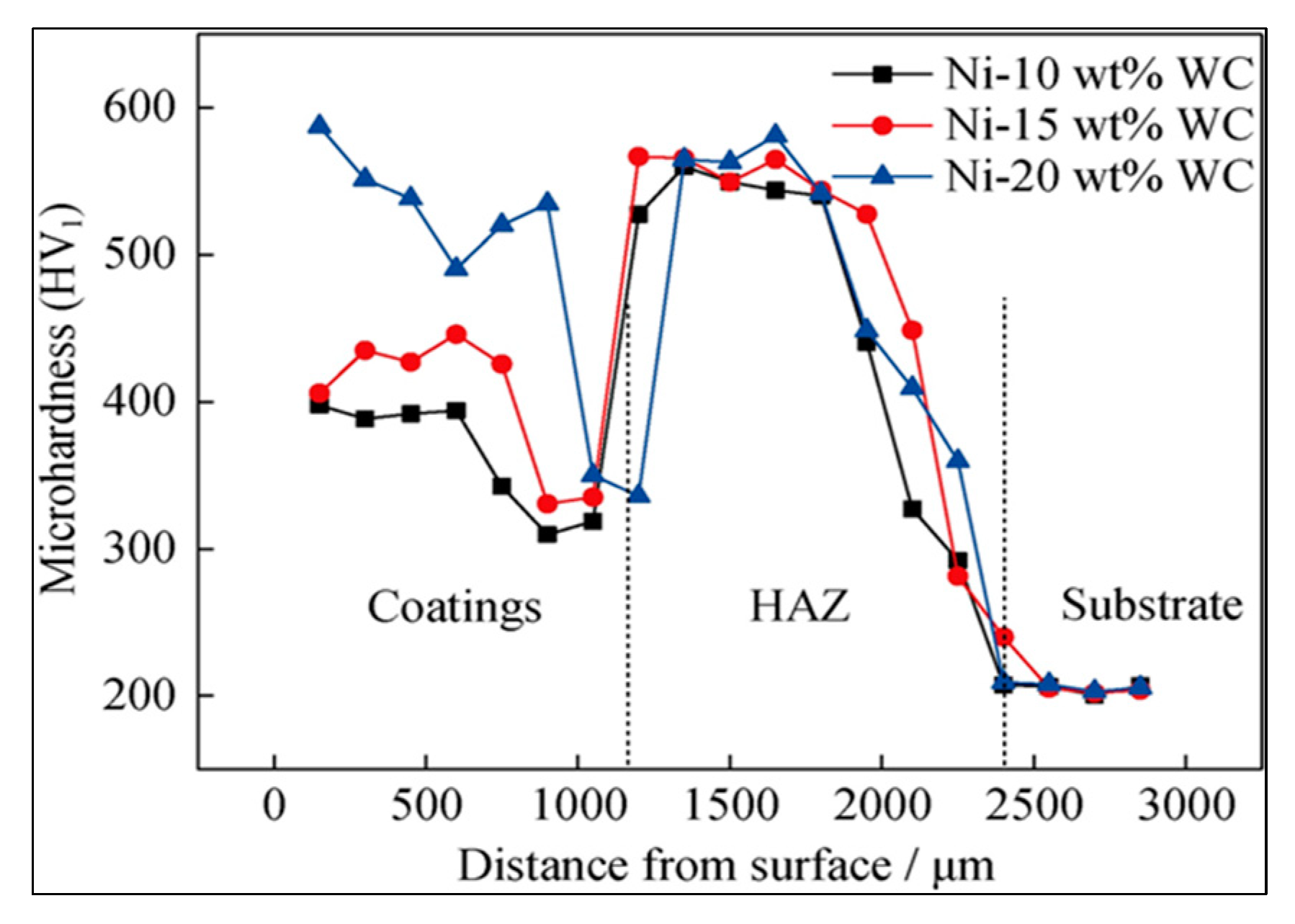
| Manufacturing Process | Exposure Temperature & Duration | Interpretation w.r.t. Phases/Precipitates | Lattice Parameter (pm) | Source |
|---|---|---|---|---|
| DLD, as deposited | --- | γ′/γ″/δ precipitated | 360.01 | [34] |
| DLD | 800 °C/1 h | Probable partial dissolution of γ″ increases lattice constant | 360.22 | [34] |
| DLD | 1000 °C/1 h | Nb comes out of the matrix, consumed by δ precipitates | 360.09 | [34] |
| DLD | 1100 °C/1 h | δ precipitates dissolve in the matrix | 360.34 | [34] |
| Wrought | As received | Mo, Nb within the matrix; large lattice distortion | 360.146 | [24] |
| Wrought | 600 °C/1 h | γ″ precipitated; lattice constant decreased | 359.546 | [24] |
| Wrought | 900 °C/1 h | strengthening elements from precipitates are progressively dissolved back into the matrix; the lattice constant increased | 360.145 | [24] |
| Wrought | 1100 °C/1 h | Although expected to increase, the lattice constant decreases, possibly due to the presence of carbides | 360.000 | [24] |
| Matrix/Reinforcement (Particle Size in µm) Reinforcement wt.% | Powder Milling Conditions | Mech. Properties | Outcome | Reference | |||
|---|---|---|---|---|---|---|---|
| UTS (MPa) | Y.S. (MPa) | Elongation (%) | Hardness | ||||
| IN625/TiC (20–45/0.08–0.15 µm) 0.25 wt.% 0.5 wt.% 1.0 wt.% | - | 930 981 996 | 645 644 648 | 19 28 20 | 318 HV 319 HV 322 HV | Nano-TiC particles contribute to grain refinement and strengthening. | [56] |
| IN625/TiC (45–90/5–7 µm) 5 wt.% | Mixture ball milled for 8 h | - | - | - | - | Dislocation tangling at nano-TiC increases the strength | [61] |
| IN625/TiC (45–95/5–7 µm) 5 wt.% | Ball-to-powder weight ratio −5:1, a 200 rpm, 8 h | 1077 | 659 | 21 | - | An optimum specific energy input promotes denser and finer structure | [55] |
| IN625/TiC (15–45/0.04 µm) 2.5 wt.% | Ball-to-powder weight ratio −5:1, a 200 rpm, 4 h | - | - | - | 330 HV | Higher energy input/unit length results in homogenous distribution of reinforcement particles | [55] |
| IN625/TiC (20–45/0.058 µm) 2.5 wt.% | Ball-to-powder weight ratio −5:1, a 250 rpm, 12 h | 1020 | 740 | 19 | 347~369 HV | Addition of Nano-TiB2 particles leads to an increase in hardness and surface wear resistance | [62] |
| IN625/TiC (15–45/2–5 µm) 2.5 wt.% | Ball-to-powder weight ratio −5:1, a 200 rpm, 4 h Ball-to-powder weight ratio −5:1, a 200 rpm, 4 h | 1023 | - | 14.7 | 314 HV | Addition of nanoparticles significantly improved mech. Properties without sacrificing ductility | [57] |
| IN625/TiC (15–45/0.04 µm) 2.5 wt.% | Same as above | 1074 | - | 23.2 | 345 HV | do | [57] |
| IN 625/NiTi + TiB2 (15–45/0.04 µm) 5 wt.% | NiB-Ti powder synthesized by self-propagating high-temperature synthesis Ball milling at 14 rpm, 30 min | 920 | - | 33 | - | New technique for composite reinforcement synthesis. A 1.5-times increase in hardness and a 15% decrease in ductility | [63] |
| IN625/TiC (75–250/35–135 µm) 15 wt.% | Mixed mechanically in a reagent bottle for 30 min. | - | - | - | 250 HB | Stiffness of composite is improved as compared to IN625. Cracks tend to appear preferentially in TiC particles. | [60] |
Disclaimer/Publisher’s Note: The statements, opinions and data contained in all publications are solely those of the individual author(s) and contributor(s) and not of MDPI and/or the editor(s). MDPI and/or the editor(s) disclaim responsibility for any injury to people or property resulting from any ideas, methods, instructions or products referred to in the content. |
© 2023 by the authors. Licensee MDPI, Basel, Switzerland. This article is an open access article distributed under the terms and conditions of the Creative Commons Attribution (CC BY) license (https://creativecommons.org/licenses/by/4.0/).
Share and Cite
Zafar, F.; Emadinia, O.; Conceição, J.; Vieira, M.; Reis, A. A Review on Direct Laser Deposition of Inconel 625 and Inconel 625-Based Composites—Challenges and Prospects. Metals 2023, 13, 787. https://doi.org/10.3390/met13040787
Zafar F, Emadinia O, Conceição J, Vieira M, Reis A. A Review on Direct Laser Deposition of Inconel 625 and Inconel 625-Based Composites—Challenges and Prospects. Metals. 2023; 13(4):787. https://doi.org/10.3390/met13040787
Chicago/Turabian StyleZafar, Fahad, Omid Emadinia, João Conceição, Manuel Vieira, and Ana Reis. 2023. "A Review on Direct Laser Deposition of Inconel 625 and Inconel 625-Based Composites—Challenges and Prospects" Metals 13, no. 4: 787. https://doi.org/10.3390/met13040787






